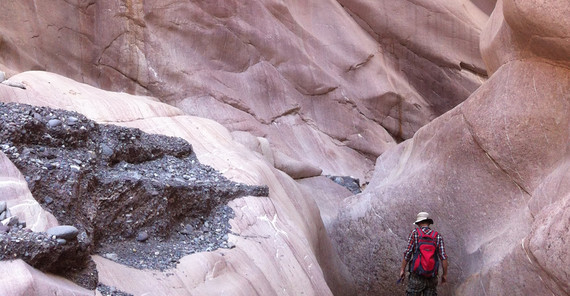The poles had no ice caps, and the sea level was 100 meters higher than today. 66 million years ago, when the dinosaurs roamed the earth, most of the earth had a tropical climate. About 34 million years ago, however, it started becoming drier and cooler. Geoscientists and climatologists are trying to understand why.
It looks like a piece of gray rock, but what geoscientist Dr. Guillaume Dupont-Nivet holds in his hands was once alive. It is a 50-million-year-old petrified oyster. A closer look at the fossil reveals its delicate structures: rings the oyster formed during its growth. For the scientist, the oyster is a climate archive that helps him decrypt what happened in primeval times.Two years ago, Dupont-Nivet came to Potsdam from France initially as a Humboldt scholarship holder but ended up staying for another project: MAGIC. In MAGIC, he and his team investigate why the climate dramatically changed millions of years ago and what the Asian monsoon had to do with it. A part of this riddle is the percentage of carbon dioxide in the atmosphere, which had been much higher than it is today before it began plummeting. “By about a quarter of the original value,” explains Dupont-Nivet. But what caused the concentration of this greenhouse gas to drop?There have been numerous theories but none have been really convincing. The researchers around Dupont-Nivet have developed a new one, though: They suspect that the intense rainfall of the monsoon triggered chemical weathering of rocks. This reaction, which still takes place, extracts carbon dioxide from the atmosphere. The resulting compound gets into the oceans via rivers and the groundwater, where it deposits as limestone on the seabed for a long time.This hypothesis supports the research Dupont-Nivet and French colleagues have conducted. Their findings indicate that the Asian monsoon has existed for at least 50 million years and not, as originally assumed, for only 22 million years. “This corresponds exactly to the period during which the climate began to cool,” the researcher emphasizes.The geo-researchers are collecting data in three areas in Asia to reconstruct the past climate in detail. In Tibet, Myanmar, and Tajikistan, they take samples of sedimentation deposited by the oceans of ancient times and measure the layer thickness. “Each is about 1000 years old,” says Dupont-Nivet. The extracted rock and ancient sediment are then analyzed in Potsdam. The scientists find pollens, minerals, fossils, and grains of sand that are between 30 and 100 million years old. The oyster fossil on the desk in the Potsdam office was found in one of these layers. The sea, in which the mollusk once lived, has long since disappeared. Mountains now stand in its place. The sea floor rose and the oyster along with it, a boon to science. Examining the chemical composition of the individual shell layers allows the predominant temperatures of the time to be deduced.The conclusions from these investigations go even further and promise answers to much more detailed questions: How strong were the monsoons in winter and summer? How strong was the wind? How did the environment change? The researchers are also reconstructing when and where seas formed and disappeared, because the water surfaces and land masses have an important influence on the origin of the monsoons.The researchers are also working on developing a climate model. “Bringing the data and the model together is one of the project’s biggest challenges,” says Dupont-Nivet. His research is also very relevant now. “In 150 years, we will have conditions similar to those 50 million years ago,” he emphasizes. The percentage of carbon dioxide in the atmosphere will probably be similar to that of the dinosaurs’ – with all the repercussions.
This research is linked to the research initiative NEXUS: Earth Surface Dynamics, which clusters approaches from various scientific disciplines in the Berlin-Brandenburg area within the overarching theme of Earth surface dynamics. The University of Potsdam, along with its partnering institutions the Helmholtz-Centre Potsdam - German Research Centre for Geosciences (GFZ), the Alfred Wegener Institute Helmholtz Centre for Polar and Marine Research (AWI) and partners from the Potsdam Institute for Climate Impact Research (PIK), the Museum für Naturkunde - Leibniz Institute for Evolution and Biodiversity Science (MfN) and the Technische Universität Berlin (TUB) therefore combines the outstanding expertise from geo-, bio-, climate and data sciences.
Text:Heike Kampe
Translation: Susanne Voigt
Online published by: Daniela Großmann
Contact: onlineredaktionuuni-potsdampde

